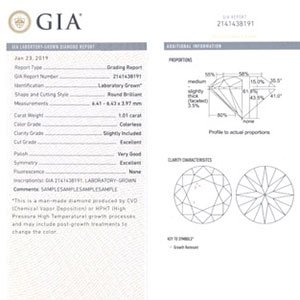

GIA Changes Lab-Grown Diamond Reports (A Little)
April 1, 2019 by Rob Bates

"In a long-awaited decision, Gemological Institute of America (GIA) has opted to change its reports for lab-grown diamonds by jettisoning the word synthetic, though it will still use a different grade scale than it does for naturals.
Formerly known as “Synthetic Diamond Reports,” the reports have been re-dubbed “Laboratory-Grown Diamond Reports”—a bow to the Federal Trade Commission (FTC) removing synthetic from its list of recommended descriptors.
But the GIA will still grade the color and clarity of man-made diamonds with descriptive ranges, rather than the more familiar detailed scale it uses for naturals. (For color, that means five ranges: colorless, near colorless, faint, very light, and light.) However, next to the ranges will be info about what grades they encompass. So instead of just grading the diamonds “near colorless,” GIA will note the grade range: G through J.
“The corresponding letters will appear next to the words,” says GIA spokesperson Stephen Morisseau. “We will say colorless. But we also say colorless is equivalent to the range D, E, F.”
According to GIA’s executive vice president and chief laboratory and research officer Tom Moses, the original GIA scale was developed in the 1950s to measure rarity. But lab-grown diamonds are harder to measure in those terms.
“[The original] continuum was one of rarity. D was the rarest, getting less rare with more yellow color. If you think of [lab-grown diamonds], there is no correlation to that. This population, if you want to grow D, you dial the knobs.”
The question for GIA was, “Does it make sense to have a system that was designed for this population distribution of natural diamonds, and apply it to [lab-grown]?” Moses says. “Or, just as happened 75 years ago, do you wait and look at [the new] distribution and then make a system, if the public wants it? Certainly, logically, that would make more sense. What the public wants, we just don’t know.”
He notes that most synthetics on the market encompass a narrow band of colors and clarities.
“As a producer, I’m going to find that efficiency band to grow them,” he says. “If they come out as K or L or M, I’m going to find a way to make them white, which is between F and H,'”
He says that GIA has found that “the colors are getting compressed, as are the clarities. [Director of research and development] Wuyi [Wang] was recently in China, buying some things. And I said, ‘Get some really low quality.’ There are none.”
So GIA worried that, ... "
https://www.jckonline.com/editorial-art ... -334329457